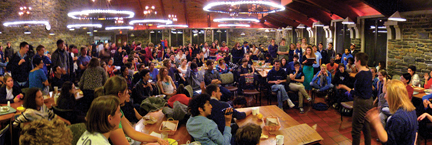Students find voice in occupy-style General Assembly
 In the early hours of Thursday, Nov. 17, New York City police cleared Occupy Wall Street protesters from Zuccotti Park in Manhattan, suspending, at least for a time, the first phase of a movement that by November, had launched dozens of Occupy protests and encampments around the country. Some had been dispersed, sometimes violently, by police; some lingered passively into the late fall.
In the early hours of Thursday, Nov. 17, New York City police cleared Occupy Wall Street protesters from Zuccotti Park in Manhattan, suspending, at least for a time, the first phase of a movement that by November, had launched dozens of Occupy protests and encampments around the country. Some had been dispersed, sometimes violently, by police; some lingered passively into the late fall.
That night, shortly after dinner in Sharples Dining Hall, Swarthmore students held their first “General Assembly (GA).” It may seem surprising that Occupy came so late to the College. Yet numerous students and alumni were participating in the Philadelphia and New York protests. Plus, one of the architects of the Wall Street protest was Micah White ’04, who worked with Adbusters founding editor Kalle Lasn and other activists to propose the Occupy strategy in a series of emails last spring. A self-described “mystical anarchist,” White was interviewed in a Nov. 28 New Yorker article on Occupy Wall Street written by Mattathias Schwartz ’01, who reported that “After earning a B.A. at Swarthmore, [White] wrote a letter to Lasn, whom he had never met, saying that he would be arriving in Vancouver in a matter of weeks and wanted to be put to work.”
Back in Sharples, tables were pushed back and chairs rearranged in the “big room,” as dozens of students began a collective conversation using the “human microphone” method pioneered at the Zuccotti encampment.
Predictably, the students’ targeted the established order at Swarthmore—“the administration.” Like the Occupy movement itself, Swarthmore’s GA did not put forward a specific set of demands.
The Daily Gazette reported that students voiced frustration with what they saw as “a behind-closed-doors attitude” on matters such as College’s budget and investment practices.
Finger twinkles—described in the Gazette as “a wiggly-fingered hand gesture the audience adopted to communicate excitement and solidarity”—greeted several speakers as they put forward such complaints.
Also garnering “a significant amount of attention” was last fall’s proposal by a group of women students to reinstate campus sororities and the “ensuing brouhaha” it caused among other students. “Though no one went so far as to suggest banning Greek life on campus,” the Gazette reported, “a handful of speakers called [sororities] an essentially gender-discriminatory institution. Others expressed support of the sorority idea.”
The first Swarthmore GA ended with mutual agreement to hold another gathering soon, and the debate went on—as campus debates often do—in the comments section of the Gazette.
Whether or not to continue using the “human microphone” was a big question, and when the General Assembly reconvened on Dec. 1, with about 75 students in attendance, the conversation started with:
“Should we use…”
“SHOULD WE USE!”
“the human mic…”
“THE HUMAN MIC”
“or an electric mic?”
“OR AN ELECTRIC MIC!”
Use of the human mic was reaffirmed by a show of hands and the students’ experiment in “direct democracy” continued.
 Email This Page
Email This Page